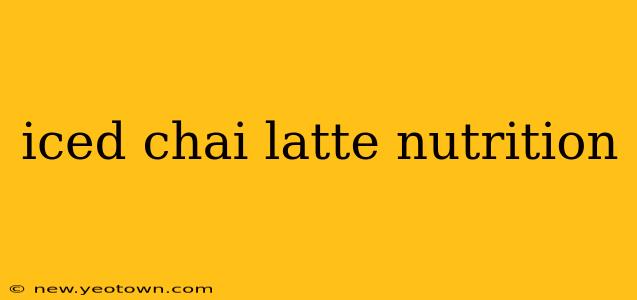The aroma of warm spices, the comforting coolness of iced tea – the iced chai latte has become a beloved beverage for its unique blend of flavor and refreshment. But beyond its delightful taste, what's the nutritional profile of this popular drink? Let's delve into the world of iced chai latte nutrition, exploring its calorie count, ingredients, and potential health impacts.
What are the main ingredients in an iced chai latte?
The foundation of any iced chai latte is, of course, chai tea. This blend typically features black tea infused with aromatic spices like cinnamon, cardamom, ginger, cloves, and black pepper. The specific spice blend can vary significantly depending on the brand and recipe. Milk, usually dairy or a non-dairy alternative like almond or soy milk, adds creaminess and richness. Finally, sweetener—sugar, honey, or syrups—is often added to enhance the flavor, although many opt for unsweetened versions.
How many calories are in an iced chai latte?
The calorie count of an iced chai latte is highly variable. A grande-sized iced chai latte from a popular coffee chain can easily contain 200-300 calories or more, largely dependent on the amount of milk and added sweetener. A homemade version, using less sweetener and lower-fat milk alternatives, can significantly reduce the calorie count. Choosing unsweetened options and using low-fat or non-dairy milk can substantially lower the overall caloric intake. Always check the nutritional information provided by the specific establishment or recipe you are using for the most accurate count.
Is iced chai latte good for you? What are the health benefits?
While an iced chai latte isn't a health food in the strictest sense, it can offer some potential health benefits. The spices in chai tea, particularly ginger and cinnamon, are known for their anti-inflammatory properties. Black tea itself is a source of antioxidants, which can help protect cells from damage. However, these benefits are often diminished by the addition of large amounts of sugar or high-fat dairy milk. Choosing lower-calorie milk alternatives and reducing or eliminating added sugar can maximize the potential health benefits of the drink.
How much sugar is in an iced chai latte?
The sugar content varies tremendously. A store-bought iced chai latte can contain a significant amount of added sugar, often exceeding 20 grams in larger sizes. This is a major contributing factor to the overall calorie count and can negatively impact blood sugar levels. Homemade versions offer greater control over sugar content, allowing for the use of natural sweeteners in moderation or even opting for an entirely unsweetened beverage.
What are the nutritional values of different types of iced chai lattes? (e.g., dairy vs. non-dairy milk)
The nutritional profile changes drastically depending on the type of milk used. Dairy milk adds calories, fat, and protein, while non-dairy alternatives like almond or soy milk usually have fewer calories and less fat. However, some non-dairy options may contain added sugars. Consider your individual dietary needs and preferences when choosing your milk. The spice blend also influences the nutritional content, although the differences are usually less significant than the choice of milk and sweetener.
Are there healthier ways to make an iced chai latte?
Absolutely! Making your iced chai latte at home allows for complete control over the ingredients. Using unsweetened chai tea bags, low-fat or non-dairy milk, and a minimal amount of natural sweetener (or none at all) can dramatically improve the nutritional profile. Experiment with different spices to customize the flavor to your liking.
In conclusion, the nutritional value of an iced chai latte is highly dependent on the ingredients and their quantities. By making informed choices about milk, sweetener, and overall preparation, you can enjoy this refreshing beverage while minimizing its potential downsides and maximizing its potential health benefits. Always check nutrition labels and consider homemade options for greater control over your drink's composition.

